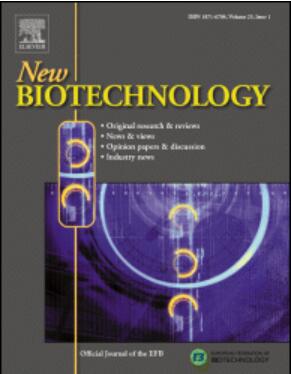Microbial synthesis of polyhydroxyalkanoate blends with engineered Pseudomonas putida
IF 4.9
2区 生物学
Q1 BIOCHEMICAL RESEARCH METHODS
引用次数: 0
Abstract
Polyhydroxyalkanoates (PHAs) are biopolymers naturally produced by various microorganisms and offer a sustainable alternative to fossil fuel-derived plastics. They can be synthesized from diverse feedstock, including waste biomass such as lignocellulose, municipal waste, sludge, and industrial by-products. To tailor their properties for specific applications, PHAs are typically blended post synthesis. An alternative approach is the direct synthesis of PHA blends in a single fermentation, which can reduce the need for multiple separate fermentations and extractions. In this study, we engineered Pseudomonas putida to synthesize PHA blends composed of poly-3-hydroxybutyrate [P3(HB)] and medium-chain-length PHA (mcl-PHA). Through using different promoters, blends with 3HB monomer content ranging from 17.9 mol% to 99.6 mol% were produced. Optimizing cultivation conditions yielded a maximum PHA production of 1.48 ± 0.15 g/L, with a PHA content of 52.2 ± 4.3 wt% of cell dry weight. A combination of gel permeation chromatography, nuclear magnetic resonance and diffusion ordered spectroscopy were employed to determine the molecular weight and confirm the identity of the PHA blend, revealing in all cases, a higher molecular weight P(3HB) than mcl-PHA. The blends produced had thermal properties comparable to PHA blends produced by post synthesis melt compounding. This work demonstrates the microbial synthesis of PHA blends in P. putida and is the first instance of blend composition control via promoter selection, paving the way for the one-step biomanufacturing of customizable PHA blends.
聚羟基烷酸酯与工程恶臭假单胞菌共混物的微生物合成。
聚羟基烷酸酯(PHAs)是由各种微生物自然产生的生物聚合物,是化石燃料衍生塑料的可持续替代品。它们可以由多种原料合成,包括废弃生物质,如木质纤维素、城市垃圾、污泥和工业副产品。为了适应特定的应用,pha通常在合成后混合。另一种方法是在单次发酵中直接合成PHA混合物,这可以减少多次单独发酵和提取的需要。在这项研究中,我们利用恶臭假单胞菌合成了由聚3-羟基丁酸酯[P3(HB)]和中链长度PHA (mcl-PHA)组成的PHA混合物。通过使用不同的促进剂,制得3HB单体含量为17.9 ~ 99.6mol%的共混物。优化培养条件后,最大PHA产量为1.48±0.15g/L, PHA含量为细胞干重的52.2±4.3wt%。结合凝胶渗透色谱、核磁共振和扩散有序光谱测定了PHA共混物的分子量,并确认了PHA共混物的身份,结果表明,在所有情况下,P(3HB)的分子量都高于mcl-PHA。所生产的共混物具有与合成后熔融复合生产的PHA共混物相当的热性能。这项工作展示了在恶臭杆菌中微生物合成PHA混合物,并且是通过启动子选择控制混合物成分的第一个实例,为可定制PHA混合物的一步生物制造铺平了道路。
本文章由计算机程序翻译,如有差异,请以英文原文为准。
求助全文
约1分钟内获得全文
求助全文
来源期刊

New biotechnology
生物-生化研究方法
CiteScore
11.40
自引率
1.90%
发文量
77
审稿时长
1 months
期刊介绍:
New Biotechnology is the official journal of the European Federation of Biotechnology (EFB) and is published bimonthly. It covers both the science of biotechnology and its surrounding political, business and financial milieu. The journal publishes peer-reviewed basic research papers, authoritative reviews, feature articles and opinions in all areas of biotechnology. It reflects the full diversity of current biotechnology science, particularly those advances in research and practice that open opportunities for exploitation of knowledge, commercially or otherwise, together with news, discussion and comment on broader issues of general interest and concern. The outlook is fully international.
The scope of the journal includes the research, industrial and commercial aspects of biotechnology, in areas such as: Healthcare and Pharmaceuticals; Food and Agriculture; Biofuels; Genetic Engineering and Molecular Biology; Genomics and Synthetic Biology; Nanotechnology; Environment and Biodiversity; Biocatalysis; Bioremediation; Process engineering.
 求助内容:
求助内容: 应助结果提醒方式:
应助结果提醒方式:


